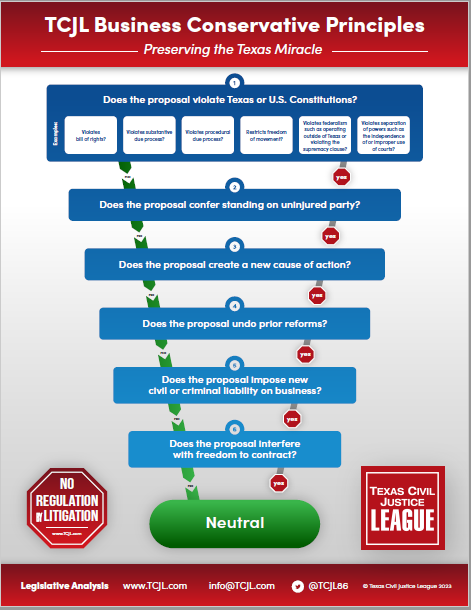 An apparently agreed version of the business court clean-up legislation, HB 40, has passed the House. The Senate version, SB 2883, has already been heard in Senate Jurisprudence. The agreed version is somewhat skinnier than the bill originally filed in the House (only a shell bill was filed in the Senate). Most significantly, HB 40 reduces the amount in controversy threshold for “qualified transactions” from $10 to $5 million. The bill also eliminates the sunset date for the six rural divisions, though no funding has been provided to activate them in the next biennium. It further fixes last session’s oversight in which business court judges didn’t get the district judges’ salary supplement.
An apparently agreed version of the business court clean-up legislation, HB 40, has passed the House. The Senate version, SB 2883, has already been heard in Senate Jurisprudence. The agreed version is somewhat skinnier than the bill originally filed in the House (only a shell bill was filed in the Senate). Most significantly, HB 40 reduces the amount in controversy threshold for “qualified transactions” from $10 to $5 million. The bill also eliminates the sunset date for the six rural divisions, though no funding has been provided to activate them in the next biennium. It further fixes last session’s oversight in which business court judges didn’t get the district judges’ salary supplement.
The engrossed bill:
- Amends § 11.101(e), CPRC, to clarify that a prefiling order entered by the business court applies to each court in the state.
- Amends § 15.003(c), CPRC, to provide that an interlocutory appeal from the business court must be taken to the 15th Court of Appeals.
- Amends numerous statutory provisions to add “business court” where the statutes refer to district or county courts;
- Amends § 65.022, CPRC, to authorize a business court judge to grant a writ returnable to anothr business court judge if that judge cannot be reached by the ordinary and available means of travel and communication in sufficient time to implement the purpose sought for the writ;
- Amends § 151.011, CPRC, to clarify that a special judge’s verdict must comply with the requirements for a verdict by the “referring” court, “including any applicable requirements for the issuance of a written opinion”;
- Conforms § 151.012, CPRC, to include any applicable written opinion requirement if the special judge does not timely submit the verdict;
- Clarifies that Chapters 171 and 172, CPRC (Texas Arbitration Act and arbitration of international commercial disputes) do not confer on the business any new or additional jurisdiction;
- Amends § 171.096, CPRC, to require an initial application for arbitration filed in a business court to establish venue in a county in a division of the court;
- Amends § 25A.001(4), Government Code, to clarify that a “qualified transaction” includes a “series of related transactions”;
- Makes active (contingent on funding, which is not provided for the next biennium) the Second, Fifth, Sixth, Seventh, Ninth, and Tenth Divisions, and includes Montgomery County in the existing Eleventh Division;
- Amends § 25A.004(d), to reduce the amount in controversy threshold from $10 to $5 million for actions arising from a qualified transaction and adds a “business” or “investment” contract or transaction in which the parties agreed to submit disputes to the business court;
- Adds an action to enforce an arbtration agreement, appoint an arbitrator, or review an arbitral award regardless of the amount in controversy if the claim is otherwise within the court’s jurisdiction;
- Adds actions arising or related to intellectual property and trade secrets;
- Clarifies that the amount in controversy for jurisdictional purposes is the total amount of all joined parties’ claims;
- Expands the court’s supplemental jurisdiction to include a claim requiring joinder or intervention of an additional party and removes the current law requirement that a party can block proceeding on a claim within the court’s supplemental jurisdiction by not agreeing to it;
- Clarifies that the business court does not jurisdictionover a claim seeking to foreclose on a lien on real or personal property “an individual owns at the time the action is filed” (unless the claim falls within the court’s supplemental jurisdiction);
- Excludes claims related to a consumer transaction as defined by § 601.001, Business & Commerce Code, to which a consumer is a party arising out of a violation of state or federal law, regardless of whether the claim is otherwise within the court’s supplemental jurisdiction;
- Instructs SCOTX to adopt rules of civil and judicial procedure for the court;
- Provides that a party’s governing documents may establish venue in the court;
- Authorizes the governor to appoint an additional judge to each of the First and Eleventh Divisions (if the Legislature makes a specific appropriation);
- Establishes a procedure by which business court judges select an administrative presiding judge pro tempore for a two-year term;
- Provides for assignment of a judge or transfer of a case on recusal;
- Entitles a business court judge to reimbursement for expenses;
- Makes various changes related to the administration of the business court system;
- Allows counties to seek reimbursement from the state for providing counrtoom space;
- Authorizes the chief justice to assign an active business court judge to serve as a visiting judge of a court located in the judge’s division;
- Requires OCA to report on the case activity of a court during the prior year;
- Provides that actions commenced on or before 9/1/24 that are within the business court’s jurisdiction may be transferred to and heard by the court on a motion of a party;
- Entitles a business court judge to additional compensation from the state in the amount equal to the difference between the judge’s base salary and the maximum combined base salary from all state and county sources paid to district judges (entitles a business court judge serving as an APJ an additional amount);
- Makes additional conforming changes.











